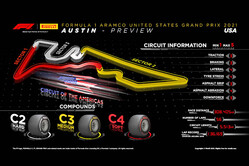


18/10/2021
NEWS STORY
 Following a year out due to the Covid-19 pandemic in 2020, Austin returns to the Formula 1 calendar this year with a slightly new look. During 2020 the track underwent a partial resurfacing, involving around 40% of its total length. Although the roughness of the new asphalt has not been measured yet, Pirelli has confirmed the same nomination as two years ago in Austin based on the available data, with the three compounds in the middle of the range: C2 as the P Zero White hard, C3 as the P Zero Yellow medium, and C4 as the P Zero Red soft.
Following a year out due to the Covid-19 pandemic in 2020, Austin returns to the Formula 1 calendar this year with a slightly new look. During 2020 the track underwent a partial resurfacing, involving around 40% of its total length. Although the roughness of the new asphalt has not been measured yet, Pirelli has confirmed the same nomination as two years ago in Austin based on the available data, with the three compounds in the middle of the range: C2 as the P Zero White hard, C3 as the P Zero Yellow medium, and C4 as the P Zero Red soft.
These tyres are well-matched to the wide range of demands imposed by the famous Texan circuit, which first joined the Formula 1 calendar in 2012. The track contains a bit of everything, with the layout having been inspired by different corners from some of the most famous tracks in the world.
The weather in Texas at this time of year can be unpredictable. The selection of compounds chosen is consequently quite adaptable to a wide variety of temperatures, although this year's race is being held earlier in the season than last time.
Track Characteristics
The circuit has been resurfaced in quite few place: the start-finish straight (including the pit lane exit) to the exit of Turn 1, the exit of Turn 9 through to Turn 10, the exit of Turn 11 through to Turn 12, and Turn 15 through to Turn 19.
Some depressions in the asphalt (between Turn 2 and Turn 3, as well as near Turns 4, 6, 10 and 14) have been fixed using a "milling" process, to make the surface more even.
One of the most unusual features about COTA is the distinctive Turn 1, which is an uphill left-hand hairpin. This makes it quite hard to judge the braking point: especially at the start. Austin is one of the most demanding tracks of all in terms of lateral energy, with several high-speed corners between 250 and 270kph in the first sector and lateral forces up to 4.5g (especially in Turn 6, for three seconds).
The Circuit of the Americas hasn't been used extensively recently, which should lead to quite a 'green' track at the beginning of the weekend. However, Formula 4 and W series are on the menu (rather than Formula 2 or Formula 3) so this means a high degree of track evolution as more rubber is laid down.
The winning strategy in 2019 was a two-stopper (medium-hard-medium) from Mercedes driver Valtteri Bottas, while his team mate Lewis Hamilton finished second with a medium-hard one-stopper. All three compounds played an important role during the race.
Mario Isola: "Although the teams have quite a lot of experience of Austin, this year they face a track that has changed a bit compared to 2019, when we last raced here. Around 40% of the track has been resurfaced but due to COVID-19 restrictions we were not able to send our personnel to analyse the new asphalt, so its characteristics are a question mark for everyone and we will only discover the final effects on tyres and car performance in general when we are there.
"As usual, the tyre nomination was done based on data obtained before the race, with the compounds in the middle of the range well-suited to the circumstances. With the championship battle so finely poised as we enter the final few races of the season, it's clear that every element of strategy will count - as we saw at the last race in Turkey."